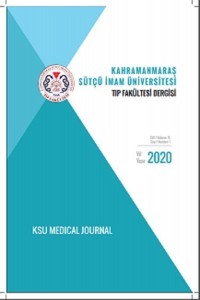Menopozal Semptomlar ve Etkileyen Faktörler: Türk Kadınları Örneği
menopoz, menopozal semptomlar, hemşirelik
MENOPAUSAL SYMPTOMS AND FACTORS AFFECTING IT: A SAMPLE OF TURKISH WOMEN
menopause, menopausal symptoms, nursing,
___
- 1- Takahashi TA, Johnson KM. Menopause. Med Clin North Am. 2015; 99(3): 521-34.
- 2- Hoga L, Rodolpho J, Gonçalves B, Quirino B. Women's experience of menopause: a systematic review of qualitative evidence. JBI Database System Rev Implement Rep. 2015;13(8):250-337.
- 3- WHO Scientific Group. Research on the menopause in the 1990s. WHO Technical Report Series 866. Geneva: World Health Organization, 1996.
- 4- Gharaibeh M, Al-Obeisat S, Hattab J. Severity of menopausal symptoms of Jordanian women. 2010;13(4):385-394
- 5- Amore M, Donato PD, Berti A, Palareti A, Chirico C, Papalini A, Zucchini S. Sexual and psychological symptoms in the climacteric years. Maturitas 2006; 56(3): 303-11.
- 6- Hidayet NM, Sharaf SA, Aref TA, Tawfik TA. Moubarak II Correlates of age at natural menopause: a community-based study in Alexandria. EMHJ 1999; 5(2): 307-19.
- 7- Turkey Demographic and Health Survey (TDHS-2013) . Hacettepe University Institute of Population Studies. Ankara, Turkey. http://www.hips.hacettepe.edu.tr/eng/ 8.Kolsky K. Menopause Time For A Change, National Institutes of Health U.S. Department of Health& Human Services, 2010:1-38.
- 9. Çelik AS, Pasinlioğlu T. Symptoms experienced in climacteric period and the role of nurse. ERÜ Sağlık Bilimleri Fakültesi Dergisi 2013; 1: 48-56.
- 10. Özgür G, Yıldırım S, Komutan A. Self Care Agency in The Postmenopausal Women and Effectıve Factors. Journal of Anatolia Nursing and Health Sciences. 2010; 13(1): 35-43.
- 11. Rahman S, Salehin F, Iqbal A. Menopausal symptoms assessment among middle age women in Kushtia, Bangladesh. BMC ResearchNotes 2011; 4: 188.
- 12. Chuni N,Sreeramareddy C.T. Frequency of symptoms, determinants of severe symptoms, validity of and cut-off score for Menopause Rating Scale (MRS) as a screening tool: A cross-sectional survey among midlife Nepalese women. BMC Women’s Health 2011; 11(30):3-9
- 13. Chou MF, Wun YT, Pang SM. Menopausal symptoms and the menopausal rating scale among midlife chinese women in Macau, China.Women Health. 2014;54(2):115-26.
- 14. Rahman SASA, Zainudin SR, Mun VLK. Assessment of Menopausal Symptoms Using Modified Menopause RatingScale (MRS) Among Middle Age Women in Kuching, Sarawak, Malaysia. Asia Pacific FamilyMedicine 2010; 9(5): 1-6.
- 15. Simon JA, Reape KZ. Understanding the menopausal experiences of professional women. Menopause 2009; 16: 73- 6.
- 16. Scheineder HP, Heinemann LAJ, Rosemeier HP, Potthoff P, Behre HM: The Menapouse Rating Scale (MRS) Reliability of scores of menapousal complaints. Climacteric 2000; 3(1): 59-64
- 17. Gürkan CÖ. Menopoz semptomları değerlendirme ölçeğinin Türkçe forumunun güvenirlik ve geçerliliği. Hemşirelik Forumu Derg 2005; 30-5.
- 18. Sis A. The determination of the effect of menopausal symptoms of the women in menopause period to the marital adjustment. PhD thesis, Atatürk University Health Science Institute. 2010
- 19. Tao M.F, Shao H.F, Li C.B, Teng Y.C. Correlation between the modified Kupperman Index and the Menopause Rating Scale in Chinese women. Patient Preference and Adherence 2013;7: 223–229
- 20. Chedraui P, Aguirre W, Hidalgo L,Fayad L. Assessing menopausal symptoms among healthy middle aged women with the Menopause Rating Scale. Maturitas 2007; 57(3): 271-278
- 21. Nappi RE, Nijland EA. Women's perception of sexuality around the menopause: outcomes of a European telephone survey. Eur J Obstet Gynecol Reprod Biol. 2008;137 (1): 10-6.
- 22. Islam MR, Gartoulla P, Bell RJ, Fradkin P, Davis SR.Prevalence of menopausal symptoms in Asian midlife women: a systematic review. Climacteric. 2015; 18(2): 157-76.
- 23. Ergöl Ş, Eroğlu K (2001) Klimakterik dönemdeki kadınların sağlık bakımlarına ilişkin uygulama ve tutumları, Sağlık ve Toplum Dergisi, 11(1): 49-57.
- 24. Işık G, Vural G. The opinions and knowledge of the women who applied to the menopause clinic and who are put aunder hormone replacement therapy related to treatment. Hemşirelik Araştırma Dergisi, 2001; 1(1): 39-48.
- 25. Tortumluoğlu G, Pasinlioğlu T Assign the useage of altenative treatments by women who have climacteric complaints. Journal of Anatolia Nursing and Health Sciences, 2003; 6(3): 64-75.
- 26. İnceboz Ü , Demirci H , Özbaşaran F , Çoban A , Nehir S. Factors Affecting the Quality of Life in Climacteric Women in Manisa Region. Balkan Medical Journal 2010, 27 (2): 111- 16
- 27. Tan MN. V The effect of physical activity and body mass index on menopausal symptoms. Family Medicine PhD thesis, Dokuz Eylül University, İzmir, Turkey 2012
- 28. Sternfeld B, Guthrie KA, Ensrud KE, LaCroix AZ, Larson JC, Dunn AL, Anderson GL, Seguin RA, et all. Efficacy of exercise for menopausal symptoms: a randomized controlled trial. Menopause. 2014; 21(4): 330–338.
- 29. Skrzypulec V, Dąbrowska J, Drosdzol A. The influence of physical activity level on climacteric symptoms in menopausal women. Climacteric 2010; 13(4):355-361.
- 30. Sis Çelik A, Pasinlioğlu T. Women’s menopausal sypmtoms and factors affecting it during climacteric period. Hacettepe Üniversitesi Hemşirelik Fakültesi Dergisi 2014; 16–29.
- 31. Cifcili SY, Akman M, Demirkol A, Unalan PC, Vermeire E. “I should live and finish it”: a qualitative inquiry into Turkish women's menopause experience. BMC Fam Pract 2009; 10 (2): 1-9.
- ISSN: 1303-6610
- Yayın Aralığı: Yılda 3 Sayı
- Başlangıç: 2004
- Yayıncı: Kahramanmaraş Sütçü İmam Üniversitesi
Buket TUĞAN YILDIZ, Deniz TUNCEL, Gülizar SÖKMEN
Ratlarda Deneysel Olarak Oluşturulan Kolit Modelinde N-Asetil Sistein ve β-Glukanın Etkileri
Murat İSPİROĞLU, Bülent KANTARÇEKEN, Harun ÇIRALIK, Ertan BULBULOGLU
Palyatif Bakımda Nörolojik Hastalıklarda Hemşirelerin Bilgisi Yeterlimi?
Gülhan SARIÇAM, Kadriye KAHVECİ, Doğan AKDOĞAN
Hemşirelerin Palyatif Bakımla İlgili Bilgileri
Filiz TAŞ, Dilek SOYLU, Ayse SOYLU
Astımlı Çocuklarda Atak Sırasında Plazma Paraoksonaz Düzeylerinin ve PON-1 gen Polimorfizminin Önemi
Myroides Odoratus/Odoratimimus’a Bağlı İdrar Yolu Enfeksiyonu: Olgu Sunumu
Burak KÜÇÜK, Buket TUĞAN YILDIZ, Hacer UĞURLU, Murat ARAL
Fibroadenomların İçindeki ve Çevresindeki Histopatolojik Değişikliklerin Karşılaştırılması
İlke Evrim SEÇİNTİ, Didar GÜRSOY
Yanık Yoğun Bakım Ünitesi Hastalarında Sağlık Hizmeti İlişkili Enfeksiyonlar
Sevil ALKAN, Özgür GÜNAL, Süleyman KLIÇ, Alper TAHMAZ, Alper CEYLAN
